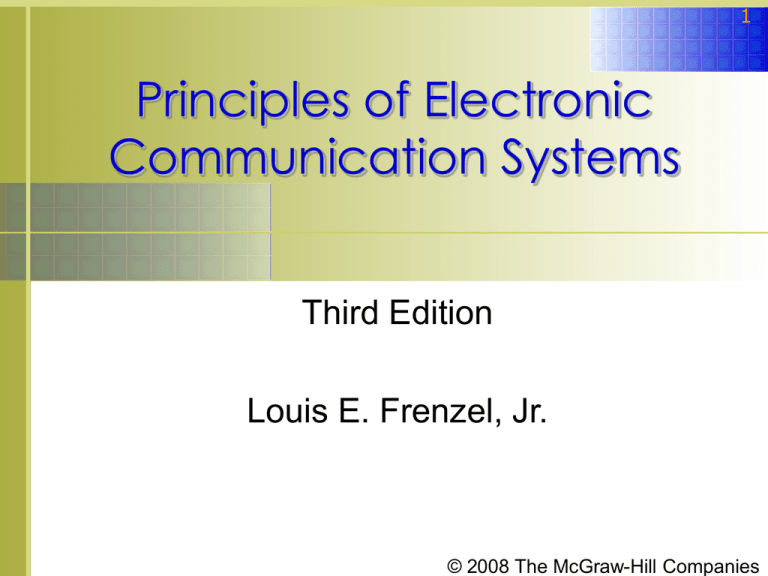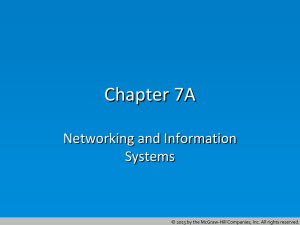Principles of Electronic Communication Systems
advertisement

1 Principles of Electronic Communication Systems Third Edition Louis E. Frenzel, Jr. © 2008 The McGraw-Hill Companies 2 Chapter 12 Introduction to Networking and Local-Area Networks © 2008 The McGraw-Hill Companies 3 Topics Covered in Chapter 12 12-1: Network Fundamentals 12-2: LAN Hardware 12-3: Ethernet LANs 12-4: Token-Ring LAN © 2008 The McGraw-Hill Companies 4 12-1: Network Fundamentals Most computers today are networked, that is, connected to one another so that they can communicate with one another and share resources. Virtually 100 percent of business and industrial computers are networked. It is estimated that more than 70 percent of all home and personal computers are also networked. © 2008 The McGraw-Hill Companies 5 12-1: Network Fundamentals A network is a communication system with two or more stations that can communicate with one another. When it is desired to have each computer communicate with two or more additional computers, the interconnections can become complex. The number of links L required between N PCs (nodes) is determined by using the formula L = N(N−1) / 2 © 2008 The McGraw-Hill Companies 6 12-1: Network Fundamentals Figure 12-1: A network of four PCs. © 2008 The McGraw-Hill Companies 7 12-1: Network Fundamentals Types of Networks Each computer or user in a network is referred to as a node. The interconnection between the nodes is referred to as the communication link. In most networks, each node is a personal computer, but in some cases a peripheral device such as a printer can be a node. © 2008 The McGraw-Hill Companies 8 12-1: Network Fundamentals Types of Networks There are four basic types of networks: Wide-area networks (WANs), Metropolitan-area networks (MANs) Local-area networks (LANs) Personal-area networks (PANs) © 2008 The McGraw-Hill Companies 9 12-1: Network Fundamentals Types of Networks: Wide-Area Networks (WANs) A WAN covers a significant geographical area. Local telephone systems are WANs, as are the many long-distance telephone systems linked together across the country and to WANs in other countries. Each telephone set is, in effect, a node in a network that links local offices and central offices. © 2008 The McGraw-Hill Companies 10 12-1: Network Fundamentals Types of Networks: Wide-Area Networks (WANs) There are also WANs that are not part of the public telephone networks, e.g., corporate and military. The nationwide and worldwide fiber-optic networks set up since the mid-1990s to carry Internet traffic are also WANs. Known as the Internet core or backbone, these highspeed interconnections are configured as either direct point-to-point links or large rings with multiple access points. © 2008 The McGraw-Hill Companies 11 12-1: Network Fundamentals Types of Networks: Metropolitan-Area Networks (MANs) MANs are smaller than WANs and generally cover a city, town, or village. Cable TV systems are MANs. Other types of MANs, or metro networks as they are typically called, carry computer data. © 2008 The McGraw-Hill Companies 12 12-1: Network Fundamentals Types of Networks: Metropolitan-Area Networks (MANs) MANs are usually fiber-optic rings encircling a city that provide local access to users. Businesses, governments, schools, hospitals, and others connect their internal LANs to them. MANs also connect to local and long-distance telephone companies. The MANs provide fast and convenient connections to WANs for global Internet connectivity. © 2008 The McGraw-Hill Companies 13 12-1: Network Fundamentals Types of Networks: Local-Area Networks (LANs) A LAN is the smallest type of network in general use. A LAN consists primarily of personal computers interconnected within an office or building. LANs can have as few as three to five users, although most systems connect to several thousand users. Home networks of two or more PCs are also LANs and today most home LANs are fully wireless or incorporate wireless segments. © 2008 The McGraw-Hill Companies 14 12-1: Network Fundamentals Types of Networks: Personal-Area Networks (PANs). A PAN is a short-range wireless network that is set up automatically between two or more devices such as laptop computers, personal digital assistants (PDAs), peripheral devices, or cell phones. The distance between the devices is very short, no more than about 10 m and usually much less. PANs are referred to as ad hoc networks that are set up for a specific single purpose, such as the transfer of data between the devices as required by some application. Most PANs just involve two nodes, but some have been set up to handle up to eight nodes and sometimes more. © 2008 The McGraw-Hill Companies 15 12-1: Network Fundamentals Types of Networks: Storage-Area Networks (SANs) SANs are an outgrowth of the massive data storage requirements developed over the years thanks to the Internet. These networks usually attach to a LAN or Internet server and store and protect huge data files. The SAN also provides network users access to massive data files stored in mass memory units, called redundant arrays of independent disks (RAIDs). RAIDs use many hard drives interconnected to the network and may be located anywhere since access can be via the Internet or a fiber-optic WAN or MAN. © 2008 The McGraw-Hill Companies 16 12-1: Network Fundamentals Types of Networks: Network Hierarchy LANs inside a building are usually connected to a MAN that may be, for example, a local telephone central office. The MANs connect to the WANs, which may be a longdistance telephone network or one set up for data transmissions. Some WANs are hierarchies of rings and direct connection points. MANs and WANs are virtually all fiber-optic networks. Interconnection points of the networks may be special computers called servers or routers. © 2008 The McGraw-Hill Companies 17 12-1: Network Fundamentals Network Topologies The topology of a network describes the basic communication paths between, and methods used to connect, the nodes on a network. The three most common topologies used in LANs are star, ring, and bus. © 2008 The McGraw-Hill Companies 18 12-1: Network Fundamentals Network Topologies: Star Topology A basic star configuration consists of a central controller node and multiple individual stations connected to it. The resulting system resembles a multipointed star. The central or controlling PC, often referred to as the server, is typically larger and faster than the other PCs and contains a large hard drive where shared data and programs are stored. © 2008 The McGraw-Hill Companies 19 12-1: Network Fundamentals Network Topologies: Star Topology A star-type LAN is extremely simple and straightforward. New nodes can be quickly and easily added to the system, and the failure of one node does not disable the entire system. If the server node goes down, the network is disabled but individual PCs will continue to operate independently. © 2008 The McGraw-Hill Companies 20 12-1: Network Fundamentals Figure 12-3: A star LAN configuration with a server as the controlling computer. © 2008 The McGraw-Hill Companies 21 12-1: Network Fundamentals Network Topologies: Ring Topology In a ring configuration, the server or main control computer and all the computers are simply linked together in a single closed loop. Usually, data is transferred around the ring in only one direction, passing through each node. The ring topology is easily implemented and low in cost. The downside of a ring network is that a failure in a single node generally causes the entire network to go down. It is also difficult to diagnose problems on a ring. © 2008 The McGraw-Hill Companies 22 12-1: Network Fundamentals Figure 12-4: A ring LAN configuration. © 2008 The McGraw-Hill Companies 23 12-1: Network Fundamentals Network Topologies: Bus Topology A bus is a common cable to which all of the nodes are attached. The bus is bidirectional in that signals can be transmitted in either directions between any two nodes. Only one node can transmit at a given time. A signal to be transmitted can be destined for a single node, or transmitted or broadcast to all nodes simultaneously. The bus is faster than other topologies, wiring is simple, and the bus can be easily expanded. © 2008 The McGraw-Hill Companies 24 12-1: Network Fundamentals Figure 12-5: A bus LAN configuration. © 2008 The McGraw-Hill Companies 25 12-1: Network Fundamentals Network Topologies: Mesh Topology A mesh network is one in which each node is connected to all other nodes. In a full mesh, every node can talk directly to any other node. There are major costs and complications as the number of nodes increases, but the use of wireless interconnections between nodes helps to alleviate this problem. © 2008 The McGraw-Hill Companies 26 12-1: Network Fundamentals Network Topologies: Mesh Topology A variation of the full mesh is the partial mesh, in which all nodes can communicate with two or more other nodes. The primary value of the mesh network is that there are multiple paths for data to take from one node to another. This offers redundancy that can provide a continuous connection when one or more of the links are broken, thus providing increased network reliability. © 2008 The McGraw-Hill Companies 27 12-1: Network Fundamentals Network Topologies: Other Topologies. There are many variations and combinations of the basic topologies. Two examples: The daisy chain topology is a ring that has been broken. The tree topology is a bus design in which each node has multiple interconnections to other nodes through a star interconnection. © 2008 The McGraw-Hill Companies 28 12-1: Network Fundamentals LAN Applications The common denominator of all LANs is the communication of information. Networks are used for many applications other than centralizing and sharing expensive peripherals and for database applications: E-mail Internet access Groupware (e.g., Lotus Notes) © 2008 The McGraw-Hill Companies 29 12-1: Network Fundamentals Client-Server and Peer-to-Peer LANs Most LANs conform to one of two general configurations: client-server or peer-to-peer. In the client-server type, one of the computers in the network, the server, essentially runs the LAN and determines how the system operates. The server manages printing operations of a central printer and controls access to a very large hard drive or bank of hard drives containing databases, files, and other information that the clients—the other computers on the network—can access. The server also provides Internet access. © 2008 The McGraw-Hill Companies 30 12-1: Network Fundamentals Client-Server and Peer-to-Peer LANs In a peer-to-peer system, any PC can serve as either client or server; any PC can have access to any other PC’s files and connected peripherals. Peer-to-peer LANs are smaller and less expensive than the client-server variety, and provide a simple way to provide network communication. Disadvantages include: Lower performance (lower-speed transmission capability). Manageability and security problems (any user may access any other user’s files). © 2008 The McGraw-Hill Companies 31 12-2: LAN Hardware All LANs are a combination of hardware and software. The primary hardware devices are the computers, cables, and connectors. Additional hardware includes: Network interface cards (NICs) Repeaters Hubs and concentrators Bridges Routers Gateways © 2008 The McGraw-Hill Companies 32 12-2: LAN Hardware Cables Most LANs use some type of copper wire cable to carry data from one computer to another via baseband transmission. The three basic cable types are: 1. Coaxial cable 2. Twisted pair 3. Fiber-optic cable © 2008 The McGraw-Hill Companies 33 12-2: LAN Hardware Cables: Coaxial Cable Coaxial cable is far superior to twisted pair as a communication medium. Its extremely wide bandwidth permits very high-speed bit rates. Loss is generally high, but is usually offset by using repeaters that boost signal level. The major benefit of coaxial cable is that it is completely shielded, so that external noise has little or no effect on it. © 2008 The McGraw-Hill Companies 34 12-2: LAN Hardware Figure 12-6: Coaxial cable. © 2008 The McGraw-Hill Companies 35 12-2: LAN Hardware Cables: Twisted Pair Twisted pair cable is two insulated copper wires twisted together loosely to form a cable. Telephone companies use twisted pair to connect individual telephones to the central office. The wire is solid copper, 22, 24, or 26 gauge. The insulation is usually PVC. Twisted pair has a characteristic impedance of about 100 Ω. © 2008 The McGraw-Hill Companies 36 12-2: LAN Hardware Figure 12-7 Types of twisted-pair cable. (a) Twisted-pair unshielded (UTP) cable. (b) Multiple shielded twisted-pair (STP) cable. © 2008 The McGraw-Hill Companies 37 12-2: LAN Hardware Cables: Twisted-Pair Cable There are two basic types of twisted-pair cables in use in LANs: 1. Unshielded (UTP): UTP cables are susceptible to noise, particularly over long cable runs. 2. Shielded (STP): STP cables are more expensive than UTP cables. They have a metal foil or braid shield around them, forming a third conductor. The shield is usually connected to ground and, therefore, provides protection from external noise and crosstalk. © 2008 The McGraw-Hill Companies 38 12-2: LAN Hardware Cables: Twisted-Pair Cable The most widely used UTP is category 5 (CAT5). It can carry baseband data at rates up to 100 Mbps at a range up to 100 m. Twisted-pair cable specifications also include attenuation and near-end cross talk figures. Attenuation means the amount by which the cable attenuates the signal. The longer the cable, the greater the amount of loss in the cable and the smaller the output. © 2008 The McGraw-Hill Companies 39 12-2: LAN Hardware Cables: Twisted-Pair Cable Near-end cross talk (NEXT): Cross talk refers to the signal transferred from one twisted pair in a cable to another by way of capacitive and inductive coupling. Near-end cross talk is the signal appearing at the input to the receiving end of the cable. Many newer office buildings are constructed with special vertical channels or chambers, called plenums, through which cables are run between floors or across ceilings. Cable used this way, called plenum cable, must be made of fireproof material that will not emit toxic fumes if it catches fire. © 2008 The McGraw-Hill Companies 40 12-2: LAN Hardware Cables: Fiber-Optic Cable Fiber-optic cable is a nonconducting cable consisting of a glass or plastic center cable surrounded by a plastic cladding encased in a plastic outer sheath. Most fiber-optic cables are extremely thin glass, and many are usually bundled together. Special fiber-optic connectors are required to attach them to the network equipment. Speeds of up to 1 Tbps (terabits per second) are achievable by using fiber optics. © 2008 The McGraw-Hill Companies 41 12-2: LAN Hardware Figure 12-9: Fiber-optic cable. © 2008 The McGraw-Hill Companies 42 12-2: LAN Hardware Connectors: Coaxial Cable Connectors All cables used in networks have special terminating connectors that provide a fast and easy way to connect and disconnect the equipment from the cabling and maintain the characteristics of the cable. Coaxial cables in networks use two types of connectors: 1. N connectors are widely used in RF applications 2. BNC connectors are commonly used for attaching test leads to measuring instruments such as oscilloscopes. © 2008 The McGraw-Hill Companies 43 12-2: LAN Hardware Connectors: Coaxial Cable Connectors BNC T connectors are used to interconnect two cables to the network hardware. The barrel connector provides a convenient way to connect two coaxial cables. A terminator is a special connector containing a resistor whose value is equal to the characteristic impedance of the coaxial cable (typically 50Ω). © 2008 The McGraw-Hill Companies 44 12-2: LAN Hardware Figure 12-10: Common coaxial connectors. © 2008 The McGraw-Hill Companies 45 12-2: LAN Hardware Figure 12-11: BNC connector accessories and adapters. (a) T connector. (b) Barrel connector. © 2008 The McGraw-Hill Companies 46 12-2: LAN Hardware Connectors: Twisted-Pair and Fiber-Optic Connectors Most telephones attach to an outlet by way of an RJ-11 connector or modular plug. RJ-11 connectors are used to connect PC modems to the phone line but are not used in LAN connections. A larger modular connector known as the RJ-45 is widely used in terminating twisted pairs. A wide range of connectors are available to terminate fiber-optic cables. © 2008 The McGraw-Hill Companies 47 12-2: LAN Hardware Figure 12-12 Modular (telephone) connectors used with twisted-pair cable. (a) RJ-11. (b) RJ-45. © 2008 The McGraw-Hill Companies 48 12-2: LAN Hardware Network Interface Cards and Chips A network interface card (NIC) provides the I/O interface between each node on a network and the network wiring. NICs usually plug into the PC bus or are built into the PC motherboard and provide connectors at the rear of the computer for attaching the cable connectors. The NIC is the key hardware component in any LAN. The NIC completely defines the protocols and performance characteristics of the LAN. NICs are low in price and available from many manufacturers. © 2008 The McGraw-Hill Companies 49 12-2: LAN Hardware Figure 12-13: A network interface card. © 2008 The McGraw-Hill Companies 50 12-2: LAN Hardware Repeater A repeater is an electronic circuit that takes a partially degraded signal, boosts its level, shapes it up, and sends it on its way. Repeaters are small, inexpensive devices that can be inserted into a line with appropriate connectors or built into other LAN equipment. Most repeaters are really transceivers, bidirectional circuits that can both send and receive data. © 2008 The McGraw-Hill Companies 51 12-2: LAN Hardware Figure 12-14: Concept of a repeater. © 2008 The McGraw-Hill Companies 52 12-2: LAN Hardware Hub A hub is a central connecting box designed to receive the cable inputs from the various PC nodes and to connect them to the server. In most cases, hub wiring physically resembles a star because all cabling comes into a central point, or hub. Hubs are usually active devices containing repeaters. They amplify and reshape the signal and transmit it to all connection parts. © 2008 The McGraw-Hill Companies 53 12-2: LAN Hardware Figure 12-15: A hub facilitates interconnections to the server. © 2008 The McGraw-Hill Companies 54 12-2: LAN Hardware Bridges A bridge is a network device that is connected as a node on a network and performs bidirectional communication between two LANs. A bridge is generally designed to interconnect two LANs with the same protocol, for example, two Ethernet networks, although some perform protocol conversion. Remote bridges are special bridges used to connect two LANs that are separated by a long distance. © 2008 The McGraw-Hill Companies 55 12-2: LAN Hardware Figure 12-16: A bridge connects two LANs. © 2008 The McGraw-Hill Companies 56 12-2: LAN Hardware Switch A switch is a hublike device that is used to connect individual PC nodes to the network wiring. A switch provides a means to connect or disconnect a PC from the network wiring. Switches have largely replaced hubs in most large LANs because they greatly expand the number of possible nodes and improve performance. © 2008 The McGraw-Hill Companies 57 12-2: LAN Hardware Router Routers are designed to connect two networks. The main difference between bridges and routers is that routers are intelligent devices that have decisionmaking and switching capabilities. The basic function of a router is to expedite traffic flow on both networks and maintain maximum performance. Some routers are a combination of a bridge and a router. © 2008 The McGraw-Hill Companies 58 12-2: LAN Hardware Gateway A gateway is another internetwork device that acts as an interface between two LANs or between a LAN and a larger computer system. The primary benefit of a gateway is that it can connect networks with incompatible protocols and configurations. The gateway acts as a two-way translator that allows systems of different types to communicate. Most gateways are computers and are sometimes referred to as gateway servers. © 2008 The McGraw-Hill Companies 59 12-2: LAN Hardware Figure 12-17: A gateway commonly connects a LAN to a larger host computer. © 2008 The McGraw-Hill Companies 60 12-2: LAN Hardware Modem Modems are interfaces between PCs and standard telephone systems. Modems convert the binary signals of the computer into audio-frequency analog signals compatible with the telephone system and, at the other end, convert the analog signals back into digital signals. The most common application is one in which remote PCs use modems to connect to an Internet service provider (ISP) which provides services such as Internet access and e-mail. © 2008 The McGraw-Hill Companies 61 12-2: LAN Hardware Wireless LAN One way to avoid the expense and headache of running and maintaining LAN cabling is to use wireless LANs, which communicate via radio. Each PC in a wireless LAN must contain a wireless modem or transceiver. The radio modem transceiver converts the serial binary data from the computer to radio signals for transmission and converts the received radio signals back to binary data. Wireless LANs operate as cable-connected LANs in that any node can communicate with any other node. Most wireless LANs have a top speed of 11 to 54 Mbps. © 2008 The McGraw-Hill Companies 62 12-3: Ethernet LANs Topology and Encoding One of the oldest and by far the most widely used of all LANs is Ethernet. The original versions of Ethernet used a bus topology. Today, most use a physical star configuration. Ethernet uses baseband data-transmission methods. The serial data to be transmitted is placed directly on the bus media. Before transmission, the binary data is encoded into a unique variation of binary code known as the Manchester code. © 2008 The McGraw-Hill Companies 63 12-3: Ethernet LANs Figure 12-18: The Ethernet bus. © 2008 The McGraw-Hill Companies 64 12-3: Ethernet LANs Speed The standard transmission speed for Ethernet LANs is 10 Mbps. The most widely used version of Ethernet is called Fast Ethernet. It has a speed of 100 Mbps. Other versions of Ethernet run at speeds of 1 Gbps or 10 Gbps, typically over fiber-optic cable but also on shorter lengths of coaxial or twisted-pair cable. © 2008 The McGraw-Hill Companies 65 12-3: Ethernet LANs Transmission Medium: Coaxial Cable The original transmission medium for Ethernet was coaxial cable. However, today twisted-pair versions of Ethernet are more popular. The two main types of coaxial cable used in Ethernet networks are RG-8/U and RG-58/U. RG-8/U cable is known as thick cable, and large typeN coaxial connectors are used to make the interconnections. When thick network cable is used, it does not attach directly to the NICs. The inputs and outputs from the NIC terminate in an attachment user interface (AUI). © 2008 The McGraw-Hill Companies 66 12-3: Ethernet LANs Transmission Medium: Coaxial Cable Ethernet systems using thick coaxial cable are generally referred to as 10Base-5 systems: 10 means a 10-Mbps speed Base means baseband operation 5 designates a 500-m maximum distance between nodes, transceivers, or repeaters. Ethernet LANs using thick cable are also referred to as Thicknet. © 2008 The McGraw-Hill Companies 67 12-3: Ethernet LANs Figure 12-20: The Ethernet (10Base-5) bus. © 2008 The McGraw-Hill Companies 68 12-3: Ethernet LANs Transmission Medium: Coaxial Cable Ethernet systems implemented with thinner coaxial cable are known as 10Base-2, or Thinnet systems. The 2 indicates the maximum 200-m (actually, 185-m) run between nodes or repeaters. The most widely used thin cable is RG-58/U. It is much more flexible and easier to work with than RG-8/U cable. © 2008 The McGraw-Hill Companies 69 12-3: Ethernet LANs Figure 12-21: 10Base-2 coaxial Ethernet bus. © 2008 The McGraw-Hill Companies 70 12-3: Ethernet LANs Transmission Medium: Twisted-Pair Cable More recent versions of Ethernet use twisted-pair cable. The twisted-pair version of Ethernet is referred to as a 10Base-T network, where the T stands for twisted-pair. © 2008 The McGraw-Hill Companies 71 12-3: Ethernet LANs Transmission Medium:100-Mbps Ethernet By far the most popular version of 100-Mbps Ethernet is 100Base-TX, or Fast Ethernet. It uses two unshielded twisted pairs instead of the single pair used in standard 10Base-T. One pair is used for transmitting, and the other is used for receiving, permitting full duplex operation, which is not possible with standard Ethernet. © 2008 The McGraw-Hill Companies 72 12-3: Ethernet LANs Transmission Medium: Gigabit Ethernet Gigabit Ethernet (1 GE) is capable of achieving 1000 Mbps or 1 Gbps over category 5 UTP or fiber-optic cable. © 2008 The McGraw-Hill Companies 73 12-3: Ethernet LANs Transmission Medium: 10-Gbit Ethernet. The newest version of Ethernet is 10-Gbit Ethernet (10 GE), which permits data speeds up to 10 Gbps over fiber-optic cable. Three of the five variations of 10-Gbit Ethernet use serial data transmission. The other two use what is called wide-wavelength division multiplexing (WWDM). Also known as coarse wavelength division multiplexing (CWDM), these versions divide the data into four channels and transmit it simultaneously over four different wavelengths of infrared light near 1310 nm. WWDM is similar to frequency-division multiplexing. © 2008 The McGraw-Hill Companies 74 12-3: Ethernet LANs Access Method Access method refers to the protocol used for transmitting and receiving information on a bus. Ethernet uses an access method known as carrier sense multiple access with collision detection (CSMA/CD) Occasionally, two or more nodes may attempt to transmit at the same time. When this happens, a collision occurs and both transmitting stations will terminate transmission. The CSMA/CD algorithm calls for the sending stations to transmit again after a brief pause. The waiting interval is determined randomly. © 2008 The McGraw-Hill Companies 75 12-3: Ethernet LANs Packet Protocols The packet in the 802.3 protocol is made up of two basic parts: 1. The frame, containing the data plus addressing and error detection codes 2. An additional 8 bytes (64 bits) at the beginning, which contains the preamble and the start frame delimiter (SFD). The destination address is a 6-byte, 48-bit code that designates the receiving node. Next is a 6-byte source address that identifies the sending node. © 2008 The McGraw-Hill Companies 76 12-3: Ethernet LANs Packet Protocols Next is a 2-byte field that specifies how many bytes will be sent in the data field. The data itself is transmitted. The packet and frame end in a 4-byte frame check sequence generated by putting the entire transmitted data block through a cyclical redundancy check (CRC). © 2008 The McGraw-Hill Companies 77 12-4: Token-Ring LAN In the Token-Ring configuration, all of the nodes or PCs in the network are connected end to end in a continuous circle or loop. Data in the network travels in only one direction on the ring. The transmitted information passes through the NICs of each PC in the loop. Token Ring uses baseband transmission; the binary data is placed directly on the cable. © 2008 The McGraw-Hill Companies 78 12-4: Token-Ring LAN A modified version of the Manchester coding scheme is used with Token-Ring. Token-Ring versions running at 4- and 16-Mbps are still in use, but more recent versions run at 100Mbps and 1 Gbps. Token-ring LANs use twisted pair cable and connections are made by using RJ-45 modular connectors. © 2008 The McGraw-Hill Companies 79 12-4: Token-Ring LAN The data transmitted around the ring passes through the NIC of all PCs in the loop, so two twisted-pair cables are needed for the connection at each node. One twisted pair, the ring in (RI), comes into the card; another twisted pair, the ring out (RO), carries the data out to the next node. To make wiring simpler, the two twisted pairs in a single cable terminate at a wiring hub referred to as a multistation access unit (MAU). The wiring inside the MAU connects the PCs in a logical ring. © 2008 The McGraw-Hill Companies 80 12-4: Token-Ring LAN Figure 12-28: Token-Ring wiring. © 2008 The McGraw-Hill Companies 81 12-4: Token-Ring LAN Figure 12-29: Wiring of the Token Ring through the MAU. © 2008 The McGraw-Hill Companies 82 12-4: Token-Ring LAN Access Method The access method used by Token-Ring systems is token passing. A token is a unique binary word passed from one node to another around the ring. Whenever a node desires to transmit information, it captures the token. The NIC builds a packet or frame of information and transmits the data on the ring. After the packet of information has been received, it continues on around the ring until it comes back to the transmitting node, which takes the data off the ring. © 2008 The McGraw-Hill Companies 83 12-4: Token-Ring LAN Packet Protocol The token frame format consists of 3 bytes: a starting delimiter (SD), an access control (AC) byte, and an ending delimiter (ED). The actual token is 1 bit in the AC byte. It is followed by a frame control (FC) byte, a 6-byte destination address, and then a 6-byte source address. © 2008 The McGraw-Hill Companies 84 12-4: Token-Ring LAN Packet Protocol The data (message information) is transmitted next in a synchronous format. The data is followed by a 4-byte (32-bit) CRC frame check sequence that is generated to catch transmission errors. The packet ends with the ending delimiter and frame status (FS) bytes. © 2008 The McGraw-Hill Companies 85 12-4: Token-Ring LAN Figure 12-30: Token-Ring packet format. (a) Token. (b) Data frame. © 2008 The McGraw-Hill Companies







